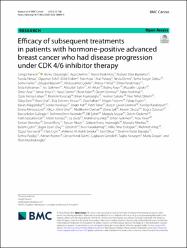| dc.contributor.author | Karacin, Cengiz | |
| dc.contributor.author | Öksüzoğlu, Berna | |
| dc.contributor.author | Demirci, Ayşe | |
| dc.contributor.author | Keskinkılıç, Merve | |
| dc.contributor.author | Baytemür, Naziyet Köse | |
| dc.contributor.author | Yılmaz, Funda | |
| dc.contributor.author | Selvi, Oğuzhan | |
| dc.contributor.author | Erdem, Dilek | |
| dc.contributor.author | Avşar, Esin | |
| dc.contributor.author | Paksoy, Nail | |
| dc.contributor.author | Demir, Necla | |
| dc.contributor.author | Göksu, Sema Sezgin | |
| dc.contributor.author | Türker, Sema | |
| dc.contributor.author | Bayram, Ertuğrul | |
| dc.contributor.author | Çelebi, Abdüssamet | |
| dc.contributor.author | Yılmaz, Hatice | |
| dc.contributor.author | Kuzu, Ömer Faruk | |
| dc.contributor.author | Kahraman, Seda | |
| dc.contributor.author | Gökmen, İvo | |
| dc.contributor.author | Sakin, Abdullah | |
| dc.date.accessioned | 2023-02-24T07:21:14Z | |
| dc.date.available | 2023-02-24T07:21:14Z | |
| dc.date.issued | 2023 | en_US |
| dc.identifier.citation | Karacin, C., Öksüzoğlu, B., Demirci, A., Keskinkılıç, M., Baytemür, N. K., Yılmaz, F. ... Sakin, A. (2023). Efficacy of subsequent treatments in patients with hormone-positive advanced breast cancer who had disease progression under CDK 4/6 inhibitor therapy. BMC Cancer, 23(1). https://doi.org/10.1186/s12885-023-10609-8 | en_US |
| dc.identifier.issn | 1471-2407 | |
| dc.identifier.uri | https://doi.org/10.1186/s12885-023-10609-8 | |
| dc.identifier.uri | https://hdl.handle.net/20.500.12511/10524 | |
| dc.description.abstract | Background: There is no standard treatment recommended at category 1 level in international guidelines for subsequent therapy after cyclin-dependent kinase 4/6 inhibitor (CDK4/6) based therapy. We aimed to evaluate which subsequent treatment oncologists prefer in patients with disease progression under CDKi. In addition, we aimed to show the effectiveness of systemic treatments after CDKi and whether there is a survival difference between hormonal treatments (monotherapy vs. mTOR-based). Methods: A total of 609 patients from 53 centers were included in the study. Progression-free-survivals (PFS) of subsequent treatments (chemotherapy (CT, n:434) or endocrine therapy (ET, n:175)) after CDKi were calculated. Patients were evaluated in three groups as those who received CDKi in first-line (group A, n:202), second-line (group B, n: 153) and ≥ 3rd-line (group C, n: 254). PFS was compared according to the use of ET and CT. In addition, ET was compared as monotherapy versus everolimus-based combination therapy. Results: The median duration of CDKi in the ET arms of Group A, B, and C was 17.0, 11.0, and 8.5 months in respectively; it was 9.0, 7.0, and 5.0 months in the CT arm. Median PFS after CDKi was 9.5 (5.0–14.0) months in the ET arm of group A, and 5.3 (3.9–6.8) months in the CT arm (p = 0.073). It was 6.7 (5.8–7.7) months in the ET arm of group B, and 5.7 (4.6–6.7) months in the CT arm (p = 0.311). It was 5.3 (2.5–8.0) months in the ET arm of group C and 4.0 (3.5–4.6) months in the CT arm (p = 0.434). Patients who received ET after CDKi were compared as those who received everolimus-based combination therapy versus those who received monotherapy ET: the median PFS in group A, B, and C was 11.0 vs. 5.9 (p = 0.047), 6.7 vs. 5.0 (p = 0.164), 6.7 vs. 3.9 (p = 0.763) months. Conclusion: Physicians preferred CT rather than ET in patients with early progression under CDKi. It has been shown that subsequent ET after CDKi can be as effective as CT. It was also observed that better PFS could be achieved with the subsequent everolimus-based treatments after first-line CDKi compared to monotherapy ET. | en_US |
| dc.description.sponsorship | Breast Cancer Consortium | en_US |
| dc.language.iso | eng | en_US |
| dc.publisher | BioMed Central Ltd | en_US |
| dc.rights | info:eu-repo/semantics/openAccess | en_US |
| dc.rights | Attribution 4.0 International | * |
| dc.rights.uri | https://creativecommons.org/licenses/by/4.0/ | * |
| dc.subject | Advanced Breast Cancer | en_US |
| dc.subject | Cyclin-Dependent Kinase | en_US |
| dc.subject | Ribociclib | en_US |
| dc.subject | Palbociclib | en_US |
| dc.subject | Everolimus | en_US |
| dc.subject | Fulvestrant | en_US |
| dc.subject | Endocrine Treatment | en_US |
| dc.subject | Hormonotherapy | en_US |
| dc.title | Efficacy of subsequent treatments in patients with hormone-positive advanced breast cancer who had disease progression under CDK 4/6 inhibitor therapy | en_US |
| dc.type | article | en_US |
| dc.relation.ispartof | BMC Cancer | en_US |
| dc.department | İstanbul Medipol Üniversitesi, Tıp Fakültesi, Dahili Tıp Bilimleri Bölümü, İç Hastalıkları Ana Bilim Dalı | en_US |
| dc.authorid | 0000-0003-2538-8569 | en_US |
| dc.identifier.volume | 23 | en_US |
| dc.identifier.issue | 1 | en_US |
| dc.relation.publicationcategory | Makale - Uluslararası Hakemli Dergi - Kurum Öğretim Elemanı | en_US |
| dc.identifier.doi | 10.1186/s12885-023-10609-8 | en_US |
| dc.institutionauthor | Sakin, Abdullah | |
| dc.identifier.wosquality | Q2 | en_US |
| dc.identifier.wos | 000980043700010 | en_US |
| dc.identifier.scopus | 2-s2.0-85147894207 | en_US |
| dc.identifier.pmid | 36765293 | en_US |
| dc.identifier.scopusquality | Q1 | en_US |



















